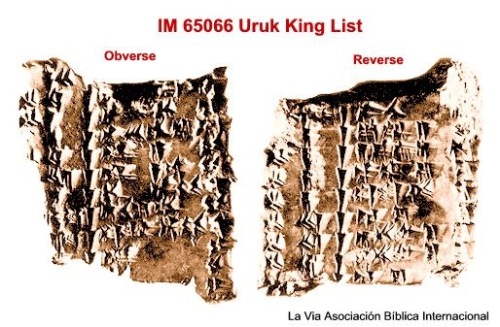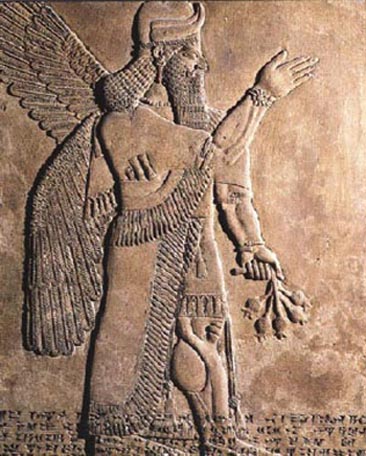Lenzi: The Uruk List of Kings and Sages
THE URUK LIST OF KINGS AND SAGES AND LATE MESOPOTAMIAN SCHOLARSHIP
ALAN LENZI
University of the Pacific
Abstract
“The Uruk List of Kings and Sages is best known for its genealogy connecting human scholars to antediluvian sages. Since its publication in 1962, however, questions pertaining to the text’s specific purpose within the context of Hellenistic Uruk have been neglected.
This study seeks to understand two such questions: why is the most explicit scholarly genealogy written in the Hellenistic period?; and who is the last named person in the text?
Seeking answers to these questions sheds new light on the text’s purpose: it is an attempt by scholars to gain support for themselves and their novel cultic agenda.
Keywords: Hellenistic Uruk, Mesopotamian scholars, Nicharkos, Antiquarianism, Anu cult

The cuneiform tablet (IM 65066) is in the Bagdad Museum.
A.K. Grayson, from the Reallexikon der Assyriologie, s.v. “Königslisten und Chroniken”.
A.K. Grayson, ‘Assyrian and Babylonian King Lists,’ in: Lišan mithurti. (Festschrift Von Soden) (Kevelaer : Neukirchen-Vluyn : Butzon & Bercker; 1969) Plate III.
http://www.livius.org/source-content/uruk-king-list/
The “Uruk List of Kings and Sages” (ULKS) was discovered in Anu’s Bīt Rēš temple by German archaeologists during the 1959/60 season and published in 1962 by van Dijk. (The tablet bears the excavation number W.20030, 7. For an edition of the text, see Jan van Dijk, “Die Inschriftenfunde,” Vorläufiger Bericht über die . . . Ausgrabungen in Uruk-Warka 18 (1962), 44-52 and plate 27).
Since then Assyriologists have cited this Seleucid-era text as the clearest cuneiform evidence that Mesopotamian scholars (ummânū) traced their professional ancestry explicitly back to the mythological sages (apkallū) of antediluvian fame and thereby implicitly to a relationship with the god Ea.
Setting this evidence alongside earlier historical data, it becomes clear that this scholarly genealogy was already functioning in the Neo-Assyrian period but probably even earlier in the late second millennium. (See, e.g., Helge S. Kvanvig, Roots of Apocalyptic: The Mesopotamian Background of the Enoch Figure and of the Son of Man, Wissenschaftliche Monographien zum Alten und Neuen Testament 61 (Neukirchen-Vluyn: Neukirchener Verlag, 1988), 202, etc.)

An ummânu, or sage of human descent. The ummânu raises his right hand in the iconic gesture of greeting, with uncertain plants in his left hand. Note the rosette design on his wristband, and the horned tiara headdress, indicative of divinity. Such human apkallū are invariably portrayed with wings.
Despite its historical importance, this genealogical aspect of our text has over-shadowed other basic questions about the Seleucid historical context in which it arose. Two such questions provide the impetus for this study:
- Despite the well-known importance of scholars in the earlier Neo-Assyrian period and the abundance of materials relating to their activities, why does one find the most explicit and systematic connection between the ummânū and apkallū in the Seleucid period?
- How does the last named and oft-overlooked individual fit into this text’s plan and into the social context of Hellenistic Uruk? (Van Dijk recognized right away that this last person is of utmost significance for the interpretation of the text and offered tentative ideas about his identity and purpose (see “Die Inschriftenfunde,” 45-46, 50, 52). I know of no other explicit treatment of this particular issue since van Dijk’s. This study attempts to build on his suggestions.)
In order to formulate a plausible answer to these questions I raise three issues very briefly that provide context. First, I review some of the earlier first millennium evidence for the genealogical connection between the ummânū and apkallū; second, I survey the Seleucid dynasty’s relationship to indigenous institutions in Mesopotamia, especially with regard to temples; and finally, I consider aspects of the archaizing theological tendencies of Urukean scribes in the late Persian and Hellenistic periods.
In light of this contextualization, I interpret the ULKS as a tendentious document written by scholars who needed to reassert their importance to the community leadership in order to advance their cultic-political agenda. Unfortunately, due to the circumstantial and at times fragmentary evidence, this interpretation can only be offered as a plausible reading and must therefore remain tentative.”
Alan Lenzi, The Uruk List of Kings and Sages and Late Mesopotamian Scholarship, JANER 8.2, Brill, Leiden, 2008. pp. 137-40.

July 29, 2015
Lenzi: A Fault Line Where Legend and History Collides
“If this were the only instance of apkallū in a ritual context, this difference in genre would be of little consequence. But, in fact, it is not.
The seven apkallū are mentioned, for example, in anti-witchcraft incantations in Maqlû II 124,36 V 110,37 VII 49,38 VIII 38 (though without names). (Note that the next line…has “the wisdom, the ingenuity of Ea they spoke.”)
They also occur in a medical incantation in LKA 146 that gives a mythological account of Ea communicating poultices to humans.
(W. G. Lambert, “The Twenty-one ‘Poultices,’” Anatolian Studies 30 (1980), 77-83. See also, e.g., Bīt rimki (Rykle Borger, “Das Dritte ‘Haus’ der Serie Bīt Rimki [VR 50-51, Schollmeyer HGS Nr.1],” Journal of Cuneiform Studies 21 [1967], 11:25 + a); the rituals treated by Wiggermann, Mesopotamian Protective Spirits; and the (overlapping) attestations noted by J. J. A. van Dijk, La Sagesse Sumero-Accadienne, Commentationes Orientales 1 (Leiden: Brill, 1953), 20, n.56.)
In this bas relief from Nimrud, human apkallū, the ummánū, kneel and tend to a sacred tree.
Both ummânū wear horned tiaras and display rosette bracelets on their wrists. Bracelets are also apparent on their upper arms.
In the lower register, bird-apkallū raise mulillu cones to sprinkle water in a gesture of exorcism and liberation of sin.
As is typical, the banduddu buckets are in their left hands.
Interestingly in this case, the bracelets are atypical, and only one rosette insignia can potentially be discerned. This sort of specificity must be deliberate. What it portends, however, remains speculative.
From such evidence Sanders has argued that the seven apkallū are restricted to myths (they are found in Erra I 162 and Gilgamesh I 21 and XI 326 (called muntalkū)) and rituals during the Neo-Assyrian period (and earlier), and this fact, in his opinion, speaks against their use in a scholarly genealogy before the Seleucid era.
(He writes, “[t]he human sages, ummânu, appear for the first time in Neo-Assyrian king lists, and in the bīt mēseri fragments of the Neo-Assyrian period the superhuman apkallū are for the first time listed by name and correlated with legendary and historical kings.
While Mesopotamian kings remain on the throne, the apkallū remain confined to myth and ritual. In the Seleucid period, after the loss of native kingship, the apkallū enter history. . . .
Evidence of a historically developing identification between the Mesopotamian ritual practitioner and the apkallū in general and Adapa in particular finally emerges in Seleucid Uruk” (Sanders, “Writing, Ritual, and Apocalypse,” 144-45).
In this Nimrud bas relief from the Louvre an ummânū sprinkles water with a mullilu cone, holding his banduddu bucket in his other hand.
This ummânū wears bracelets with a different design, as rosettes are not apparent. In this case, the design appears to consist of concentric circles.
This ummânū also wears the common horned headdress, but in this case the headdress is surmounted by an object that resembles a partial fleur de lis.
The detail on this bas relief is unusually good, revealing details about the earrings that are blurry in most other examples.
Bracelets are also apparent on the upper arms, and the banduddu bucket reveals cross-hatching detail which rarely appears in other depictions.
The realistic portrayal of fine detail on the fingernails, the toenails, and the tassels is singular. In no other example does the embroidery on the garment stand out so well.
The fine detail on the wings and the braided hair is exceptional, and this ummânū appears to be wearing a medallion or other object at his sternum, a detail not noted elsewhere.
From Nimrud, capital of king Ashurnarzipal.
Louvre, AO 19845
Sanders’ objection reminds us of the need for sensitivity to genre in adducing evidence, something few others have taken seriously when discussing the issue of scholarly genealogy.
There is, however, other non-ritual evidence that both alleviates the problem he raises and provides more support for the earlier apkallū–ummânū association suggested by the Bīt mēseri material.
A textual variant between the only two manuscripts of the Akkadian literary composition “Advice to a Prince,” which is clearly a non-ritual text, supports the close association of the apkallū and ummânū in the early first millennium. A comparison of the two tablets at lines 4 and 5 reveals our variant of interest.
(In the standard edition of the text, Lambert expresses the opinion that the text is from Babylon and should be dated to roughly 1000 to 700 BCE. He also notes, “(t)he text is written on a tablet from the libraries of Assurbanipal [i.e., DT 1], and no duplicate has yet been found” (W. G. Lambert, Babylonian Wisdom Literature [Oxford: Oxford University Press, 1960; reprinted, Winona Lake: Eisenbrauns, 1996], 110, 111).
Steven Cole has recently published a duplicate to DT 1 (Nippur IV. The Early Neo-Babylonian Governor’s Archive from Nippur, Oriental Institute Publications 114 [Chicago: The Oriental Institute of the University of Chicago, 1996], no. 128 [= OIP 114 128]); the tablet was found among a cache from Nippur.)
In the standard edition based on DT 1 (the Ninevite version), Lambert took the ME in NUN.ME-šú as a plural marker and read the word as rubû, “princes, nobles.” (Babylonian Wisdom Literature, 112-13.)
This is understandable in light of line 10 which sets NUN.ME alongside DI.KUD.ME (dayyānū, “judges”).
In the orthography of the latter term ME must indicate plurality. But Reiner has noted that DT 1 typically uses MES to express the plural (line 10’s DI.KUD.ME being the one indisputable exception); thus, it seemed likely to her that NUN.ME in both lines 4 and 10 should be read apkallū (singular.) (See Erica Reiner, “The Etiological Myth of the ‘Seven Sages,’” Orientalia 30 (1961), 9 and n.1.)”
Alan Lenzi, The Uruk List of Kings and Sages and Late Mesopotamian Scholarship, JANER 8.2, Brill, Leiden, 2008. pp. 146-8.
Share this: